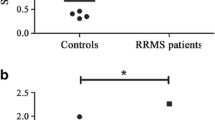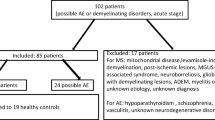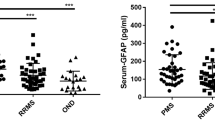Abstract
Antibodies and oxidative stress are hallmarks of multiple sclerosis (MS) lesions. We aimed to clarify the relation between them, their role in MS patients and to investigate their specificity, comparing MS with classical neurodegenerative diseases (ND). Brain samples from 14 MS cases, 6 with ND and 9 controls (without neurological diseases). Immunohistochemistry assays were used to detect oxidized lipids (EO6), IgG and IgM, oligodendrocytes (Olig2), axons (NF, neurofilament) and cellular (TUNEL) and axonal damage (APP, amyloid precursor protein). We did not observe EO6 in controls. All samples from MS patients showed EO6 in oligodendrocytes and axons within lesions. We did not detect co-localization between EO6 and antibodies. Neither did we between EO6 and TUNEL or APP. 94.4% of TUNEL-positive cells in normal appearing white matter were also stained for IgG and 75.5% for IgM. IgM, but not IgG, co-localized with APP. EO6 was associated with axonal damage in amyotrophic lateral sclerosis (ALS). We did not observe association between antibodies and cellular or axonal damage in ND patients. MS patients showed a higher number of B cells and plasma cells in the lesions and meninges than controls. The number of B cells and plasma cells was associated with the presence of antibodies and with the activity of the lesions. We observed a main role of B lymphocytes in the development of MS lesions. Antibodies contribute to the oligodendrocyte and axonal damage in MS. Oxidative stress was associated with axonal damage in ALS.









Similar content being viewed by others
Data Availability
The corresponding authors will provide anonymized data of this study on reasonable request from any qualified investigator, following relevant data protection regulations.
References
Andersson M, Alvarez-Cermeño J, Bernardi G, Cogato I, Fredman P, Frederiksen J, Fredrikson S, Gallo P, Grimaldi LM, Grønning M (1994) Cerebrospinal fluid in the diagnosis of multiple sclerosis: a consensus report. J Neurol Neurosurg Psychiatry 57:897–902. https://doi.org/10.1136/jnnp.57.8.897
Baranzini SE, Jeong MC, Butunoi C, Murray RS, Bernard CC, Oksenberg JR (1999) B cell repertoire diversity and clonal expansion in multiple sclerosis brain lesions. J Immunol 163:5133–5144
Barnett MH, Prineas JW (2004) Relapsing and remitting multiple sclerosis: pathology of the newly forming lesion. Ann Neurol 55(4):458–468
Binder CJ, Chang MK, Shaw PX, Miller YI, Hartvigsen K, Dewan A, Witztum JL (2002) Innate and acquired immunity in atherogenesis. Nat Med 8:1218–1226. https://doi.org/10.1038/nm1102-1218
Bizzozero OA, DeJesus G, Callahan K, Pastuszyn A (2005) Elevated protein carbonylation in the brain white matter and gray matter of patients with multiple sclerosis. J Neurosci Res 81:687–695. https://doi.org/10.1002/jnr.20587
Breij EC, Brink BP, Veerhuis R, van den Berg C, Vloet R, Yan R, Dijkstra CD, van der Valk P, Bö L (2008) Homogeneity of active demyelinating lesions in established multiple sclerosis. Ann Neurol 63:16–25. https://doi.org/10.1002/ana.21311
Chen S, Le WD, Xie WJ, Alexianu ME, Engelhardt JI, Siklós L, Appel SH (1998) Experimental destruction of substantianigra initiated by Parkinson disease immunoglobulins. Arch Neurol 55:1075–1080. https://doi.org/10.1001/archneur.55.8.1075
Corcione A, Casaza S, Ferretti E, Giunti D, Zappia E, Pistorio A, Gambini C, Mancardi GL, Uccelli A, Pistoia V (2004) Recapitulation of B cell differentiation in the central nervous system of patients with multiple sclerosis. ProcNatlAcadSci USA 101:11064–11069. https://doi.org/10.1073/pnas.0402455101
Cross AH, Manning PT, Keeling RM, Schmidt RE, Misko TP (1998) Peroxynitrite formation within the central nervous system in active multiple sclerosis. J Neuroimmunol 88:45–56. https://doi.org/10.1016/s0165-5728(98)00078-2
Diaz-Sanchez M, Williams K, DeLuca GC, Esiri MM (2006) Protein co-expression with axonal injury in multiple sclerosis plaques. ActaNeuropathol 111:289–299. https://doi.org/10.1007/s00401-006-0045-0
Dutta R, McDonough J, Yin X, Peterson J, Chang A, Torres T, Gudz T, Macklin WB, Lewis DA, Fox RJ et al (2006) Mitochondrial dysfunction as a cause of axonal degeneration in multiple sclerosis patients. Ann Neurol 59:478–489. https://doi.org/10.1002/ana.20736
Engelhardt JI, Appel SH (1990) IgG reactivity in the spinal cord and motor cortex in amyotrophic lateral sclerosis. Arch Neurol 47:1210–1216. https://doi.org/10.1001/archneur.1990.00530110068019
Engelhardt JI, Siklós L, Kömüves L, Smith RG, Appel SH (1995) Antibodies to calcium channels from ALS patients passively transferred to mice selectively increase intracellular calcium and induce ultrastructural changes in motoneurons. Synapse 20:185–199. https://doi.org/10.1002/syn.890200302
England JD, Gamboni F, Levinson SR, Finger TE (1990) Changed distribution of sodium channels along demyelinated axons. ProcNatlAcadSci USA 87:6777–6780. https://doi.org/10.1073/pnas.87.17.6777
Esiri M (1977) Immunoglobulin-containing cells in multiple-sclerosis plaques. Lancet 310:478–480. https://doi.org/10.1016/S0140-6736(77)91603-8
Ferguson B, Matyszak MK, Esiri MM, Perry VH (1997) Axonal damage in acute multiple sclerosis lesions. Brain 120:393–399. https://doi.org/10.1093/brain/120.3.393
Fischer MT, Sharma R, Lim JL, Haider L, Frischer JM, Drexhage J, Mahad D, Bradl M, Van Horssen J, Lassmann H (2012) NADPH oxidase expression in active multiple sclerosis lesions in relation to oxidative tissue damage and mitochondrial injury. Brain 135:886–899. https://doi.org/10.1093/brain/aws012
Fischer MT, Wimmer I, Höftberger R, Gerlach S, Haider L, Zrzavy T, Hametner S, Mahad D, Binder CJ, Krumbholz M et al (2013) Disease-specific molecular events in cortical multiple sclerosis lesions. Brain 136:1799–1815. https://doi.org/10.1093/brain/awt110
Gay FW, Drye TJ, Dick GWA, Esiri MM (1997) The application of multifactorial cluster analysis in the staging of plaques in early multiple sclerosis: identification and characterization of the primary demyelinating lesion. Brain 120:1461–1483. https://doi.org/10.1093/brain/120.8.1461
Haas J, Bekeredjian-Ding I, Milkova M, Balint B, Schwarz A, Korporal M, Jarius S, Fritz B, Lorenz HM, Wildemann B (2011) B cells undergo unique compartmentalized redistribution in multiple sclerosis. J Autoimmun 37:289–299. https://doi.org/10.1016/j.jaut.2011.08.003
Haider L, Fischer MT, Frischer JM, Bauer J, Hoftberger R, Botond G, Esterbauer H, Binder CJ, Witztum JL, Lassmann H (2011) Oxidative damage in multiple sclerosis lesions. Brain 134:1914–1924. https://doi.org/10.1093/brain/awr128
Hauser SL, Waubant E, Arnold DL, Vollmer T, Antel J, Fox R, Bar-Or A, Panzara M, Sarkar N, Agarwal S et al (2008) B-cell depletion with rituximab in relapsing-remitting multiple sclerosis. N Engl J Med 358:676–688. https://doi.org/10.1056/nejmoa0706383
Ireland SJ, Blazek M, Harp CT, Greenberg B, Frohman EM, Davis LS, Monson NL (2012) Antibody-independent B cell effector functions in relapsing remitting multiple sclerosis: clues to increased inflammatory and reduced regulatory B cell capacity. Autoimmunity 45:400–414. https://doi.org/10.3109/08916934.2012.665529
Irwin DJ (2016) Tauopathies as clinicopathological entities. Parkinsonism RelatDisord 22(Suppl 1):S29-33. https://doi.org/10.1016/j.parkreldis.2015.09.020
Jenner P, Dexter DT, Sian J, Schapira AH, Marsden CD (1992) Oxidative stress as a cause of nigral cell death in Parkinson’s disease and incidental lewy body disease the royal Kings and Queens Parkinson’s disease research group. Ann Neurol 32(Suppl):S82-87. https://doi.org/10.1002/ana.410320714
Kankaanpää J, Turunen SP, Moilanen V, Hörkkö S, Remes AM (2009) Cerebrospinal fluid antibodies to oxidized LDL are increased in Alzheimer’s disease. Neurobiol Dis 33:467–472. https://doi.org/10.1016/j.nbd.2008.12.001
Kiernan MC, Vucic S, Cheah BC, Turner MR, Eisen A, Hardiman O, Burrell JR, Zoing MC (2011) Amyotrophic lateral sclerosis. Lancet 377:942–955. https://doi.org/10.1016/s0140-6736(10)61156-7
Kim SH, Kook MC, Shin YK, Park SH, Song HG (2004) Evaluation of antigen retrieval buffer systems. J MolHistol 35:409–416. https://doi.org/10.1023/B:HIJO.0000039854.17808.e0
Kimura F, Smith RG, Delbono O, Nyormoi O, Schneider T, Nastainczyk W, Hofmann F, Stefani E, Appel SH (1994) Amyotrophic lateral sclerosis patient antibodies label Ca2+ channel alpha 1 subunit. Ann Neurol 35:164–171. https://doi.org/10.1002/ana.410350207
Liu JS, Zhao ML, Brosnan CF, Lee SC (2001) Expression of inducible nitric oxide synthase and nitrotyrosine in multiple sclerosis lesions. Am J Pathol 158:2057–2066. https://doi.org/10.1016/s0002-9440(10)64677-9
Lovato L, Willis SN, Rodig SJ, Caron T, Almendinger SE, Howell OW, Reynolds R, O’Connor KC, Hafler DA (2011) Related B cell clones populate the meninges and parenchyma of patients with multiple sclerosis. Brain 134:534–541. https://doi.org/10.1093/brain/awq350
Lucchinetti CF, Bruck W, Rodriguez M, Lassmann H (1996) Distinct patterns of multiple sclerosis pathology indicates heterogeneity on pathogenesis. Brain Pathol 6:259–274. https://doi.org/10.1111/j.1750-3639.1996.tb00854.x
Lucchinetti CF, Brück W, Parisi JE, Scheithauer B, Rodriguez M, Lassmann H (2000) Heterogenity of multiple sclerosis lesions: implication for the pathogenesis of demyelination. Ann Neurol 47:707–717. https://doi.org/10.1002/1531-8249(200006)47:6%3C707::aid-ana3%3e3.0.CO;2-q
Magliozzi R, Howell O, Vora A, Serafini B, Nicholas R, Puopolo M, Reynolds R, Aloisi F (2007) Meningeal B-cell follicles in secondary progressive multiple sclerosis associate with early onset of disease and severe cortical pathology. Brain 130:1089–1104. https://doi.org/10.1093/brain/awm038
Mahad D, Ziabreva I, Lassmann H, Turnbull D (2008) Mitochondrial defects in acute multiple sclerosis lesions. Brain 131:1722–1735. https://doi.org/10.1093/brain/awn105
Mahad DJ, Ziabreva I, Campbell G, Lax N, White K, Hanson PS, Lassmann H, Turnbull DM (2009) Mitochondrial changes within axons in multiple sclerosis. Brain 132:1161–1174. https://doi.org/10.1093/brain/awp046
Martínez A, Carmona M, Portero-Otin M, Naudí A, Pamplona R, Ferrer I (2008) Type-dependent oxidative damage in frontotemporal lobar degeneration: cortical astrocytes are targets of oxidative damage. J NeuropatholExpNeurol 67:1122–1136. https://doi.org/10.1097/NEN.0b013e31818e06f3
Masjuan J, Alvarez-Cermeño JC, García-Barragán N, Díaz-Sánchez M, Espiño M, Sádaba MC, González-Porqué P, Martínez San Millán J, Villar LM (2006) Clinically isolated syndromes: a new oligoclonal band test accurately predicts conversion to MS. Neurology 66:576–578. https://doi.org/10.1212/01.wnl.0000198253.35119.83
McGeer PL, McGeer EG, Kawamata T, Yamada T, Akiyama H (1991) Reactions of the immune system in chronic degenerative neurological diseases. Can J NeurolSci 18:376–379. https://doi.org/10.1017/S0317167100032479
Moore DJ, West AB, Dawson VL, Dawson TM (2005) Molecular pathophysiology of Parkinson’s disease. Annu Rev Neurosci 28:57–87. https://doi.org/10.1146/annurev.neuro.28.061604.135718
Obermeier B, Lovato L, Mentele R, Brück W, Forne I, Imhof A, Lottspeich F, Turk KW, Willis SN, Wekerle H et al (2011) Related B cell clones that populate the CSF and CNS of patients with multiple sclerosis produce CSF immunoglobulin. J Neuroimmunol 233:245–248
Piccio L, Naismith RT, Trinkaus K, Klein RS, Parks BJ, Lyons JA, Cross AH (2010) Changes in B- and T-lymphocyte and chemokine levels with rituximab treatment in multiple sclerosis. Arch Neurol 67:707–714. https://doi.org/10.1001/archneurol.2010.99
Polman CH, O’Connor PW, Havrdova E, Hutchinson M, Kappos L, Miller DH, Phillips JT, Lublin FD, Giovannoni G, Wajgt A et al (2006) A randomized, placebo-controlled trial of natalizumab for relapsing multiple sclerosis. N Engl J Med 354:899–910. https://doi.org/10.1056/nejmoa044397
Poser CM, Paty DW, Scheinberg L, McDonald WI, Davis FA, Ebers GC, Johnson KP, Sibley WA, Silberberg DH, Tourtellotte WW (1983) New diagnostic criteria for multiple sclerosis: guidelines for research protocols. Ann Neurol 13:227–231. https://doi.org/10.1002/ana.410130302
Prineas JW (1979) Multiple sclerosis: presence of lymphatic capillaries and lymphoid tissue in the brain and spinal cord. Science 203:1123–1125. https://doi.org/10.1126/science.424741
Rosen DR, Siddique T, Patterson D, Figlewicz DA, Sapp P, Hentati A, Donaldson D, Goto J, O’Regan JP, Deng HX (1993) Mutations in Cu/Zn superoxide dismutase gene are associated with familial amyotrophic lateral sclerosis. Nature 362:59–62. https://doi.org/10.1038/362059a0
Serafini B, Rosicarelli B, Magliozzi R, Stigliano E, Aloisi F (2004) Detection of ectopic B-cell follicles with germinal centers in the meninges of patients with secondary progressive multiple sclerosis. Brain Pathol 14:164–174. https://doi.org/10.1111/j.1750-3639.2004.tb00049.x
Stadelmann C, Wegner C, Brück W (2011) Inflammation, demyelination and degeneration - recent insights from MS pathology. BiochimBiophysActa 1812:275–282. https://doi.org/10.1016/j.bbadis.2010.07.007
Storch MK, Piddlesden S, Haltia M, Iivanainen M, Morgan P, Lassmann H (1998) Multiple sclerosis: in situ evidence for antibody- and complement- mediated demyelination. Ann Neurol 43:465–471. https://doi.org/10.1002/ana.410430409
Sádaba MC, González Porqué P, Masjuan J, Alvarez-Cermeño JC, Bootello A, Villar LM (2004) An ultrasensitive method for the detection of oligoclonalIgG bands. J Immunol Methods 284:41–145. https://doi.org/10.1016/j.jim.2003.09.018
Sádaba MC, Martín-Estal I, Puche JE, Castilla-Cortázar I (2016) Insulin-like growth factor 1 (IGF-1) therapy: mitochondrial dysfunction and diseases. BiochimBiophysActa 1862:1267–1278. https://doi.org/10.1016/j.bbadis.2016.03.010
Sádaba MC, Tzartos J, Paíno C, García-Villanueva M, Alvarez-Cermeño JC, Villar LM, Esiri MM (2012) Axonal and oligodendrocyte-localized IgM and IgG deposits in MS lesions. J Neuroimmunol 247:86–94. https://doi.org/10.1016/j.jneuroim.2012.03.020
Tsimikas S, Brilakis ES, Lennon RJ, Miller ER, Witztum JL, McConnell JP, Kornman KS, Berger PB (2007) Relationship of IgG and IgM autoantibodies to oxidized low density lipoprotein with coronary artery disease and cardiovascular events. J Lipid Res 48:425–433. https://doi.org/10.1194/jlr.m600361-jlr200
Tzartos JS, Friese MA, Craner MJ, Palace J, Newcombe J, Esiri MM, Fugger L (2008) Interleukin-17 production in central nervous system-infiltrating T Cells and glial cells is associated with active disease in multiple sclerosis. Am J Pathol 172:146–155. https://doi.org/10.2353/ajpath.2008.070690
Villar L, García-Barragán N, Espiño M, Roldán E, Sádaba M, Gómez-Rial J, González-Porqué P, Alvarez-Cermeño J (2008) Influence of oligoclonalIgM specificity in multiple sclerosis disease course. MultScler 14:183–187. https://doi.org/10.1177/1352458507082046
Villar LM, García-Sánchez MI, Costa-Frossard L, Espiño M, Roldán E, Páramo D, Lucas M, Izquierdo G, Álvarez-Cermeño JC (2012) Immunological markers of optimal response to natalizumab in multiple sclerosis. Arch Neurol 69:191–197
Villar LM, Masjuan J, González-Porqué P, Plaza J, Sádaba MC, Roldán E, Bootello A, Alvarez-Cermeño JC (2002a) IntrathecalIgM synthesis in neurologic diseases: relationship with disability in MS. Neurology 58:824–826. https://doi.org/10.1212/wnl.58.5.824
Villar LM, Masjuan J, González-Porqué P, Plaza J, Sádaba MC, Roldán E, Bootello A, Alvarez-Cermeño JC (2002b) IntrathecalIgM synthesis predicts the onset of new relapses and a worse disease course in MS. Neurology 59:555–559. https://doi.org/10.1212/wnl.59.4.555
Villar LM, Masjuan J, González-Porqué P, Plaza J, Sádaba MC, Roldán E, Bootello A, Alvarez-Cermeño JC (2003) IntrathecalIgM synthesis is a prognostic factor in multiple sclerosis. Ann Neurol 53:222–226. https://doi.org/10.1002/ana.10441
Villar LM, Masjuan J, Sádaba MC, González-Porqué P, Plaza J, Bootello A, Alvarez-Cermeño JC (2005a) Early differential diagnosis of multiple sclerosis using a new oligoclonal band test. Arch Neurol 62:574–577. https://doi.org/10.1001/archneur.62.4.574
Villar LM, Sádaba MC, Roldán E, Masjuan J, González-Porqué P, Villarrubia N, Espiño M, García-Trujillo JA, Bootello A, Alvarez-Cermeño JC (2005b) Intrathecal synthesis of oligoclonalIgM against myelin lipids predicts an aggressive disease course in MS. J Clin Invest 115:187–194. https://doi.org/10.1172/jci22833
Vladimirova O, O’Connor J, Cahill A, Alder H, Butunoi C, Kalman B (1998) Oxidative damage to DNA in plaques of MS brains. MultScler (Houndmills, Basingstoke, England) 4:413–418. https://doi.org/10.1177/135245859800400503
Wei Z, Li X, Liu Q, Cheng Y (2018) Oxidative stress in Parkinson’s disease: a systematic review and meta-analysis. Front MolNeurosci 11:236. https://doi.org/10.3389/fnmol.2018.00236
Zhang Y, Da RR, Hilgenberg LG, Tourtellotte WW, Sobel RA, Smith MA, Olek M, Nagra R, Sudhir G, van den Noort S et al (2005) Clonal expansion of IgA-positive plasma cells and axon-reactive antibodies in MS lesions. J Neuroimmunol 167:120–130. https://doi.org/10.1016/j.jneuroim.2005.05.006
Acknowledgements
We acknowledge the Oxford Brain Bank, supported by the Medical Research Council (MRC), Brains for Dementia Research (BDR) (Alzheimer Society and Alzheimer Research UK), Autistica UK and the NIHR Oxford Biomedical Research; Banco de Tejidos CIEN, Instituto Carlos III and Departamento de Anatomía de la Facultad de Medicina de la Universidad San Pablo CEU for providing human tissue; Dr. José Paredes, Dr. Silvano Heras and Dr Francisco J. García for providing tissue samples and Angelica Acebedo and Susana Arahuetes for technical help.
Funding
This work was supported by grants from the Instituto de Medicina Molecular Aplicada, Universidad San Pablo CEU (USP-BS-PPC16/2012 and MEMERG-1) and grant from the Universidad San Pablo CEU-Banco Santander (PI14/01620) to Dra. Úrsula Muñoz and by UK National Institute for Health Research (NIHR) through the Oxford Biomedical Research Centre (UK) to Professor Margaret Esiri. Cristina Sebal was supported by a fellowship grant from the Instituto de Medicina Molecular Aplicada, Universidad San Pablo CEU (Spain).
Author information
Authors and Affiliations
Contributions
UM, MCS and ES: conception and design of the study; CS, JT and CSl: acquisition and analysis of data and MCS, UM, ME, and ES: drafting a significant portion of the manuscript or figures.
Corresponding authors
Ethics declarations
Conflict of interest
Nothing to report.
Ethical Approval
The study was approved by the Ethical Committee of the Universidad San Pablo CEU (113/16/05). All the patients signed Informed consent. The donation of samples were approved by Committee of the Universidad San Pablo CEU, Instituto de Salud Carlos III (ISCIII) and Oxford University.
Additional information
Publisher's Note
Springer Nature remains neutral with regard to jurisdictional claims in published maps and institutional affiliations.
Supplementary Information
Below is the link to the electronic supplementary material.
Rights and permissions
About this article
Cite this article
Muñoz, U., Sebal, C., Escudero, E. et al. Main Role of Antibodies in Demyelination and Axonal Damage in Multiple Sclerosis. Cell Mol Neurobiol 42, 1809–1827 (2022). https://doi.org/10.1007/s10571-021-01059-6
Received:
Accepted:
Published:
Issue Date:
DOI: https://doi.org/10.1007/s10571-021-01059-6




